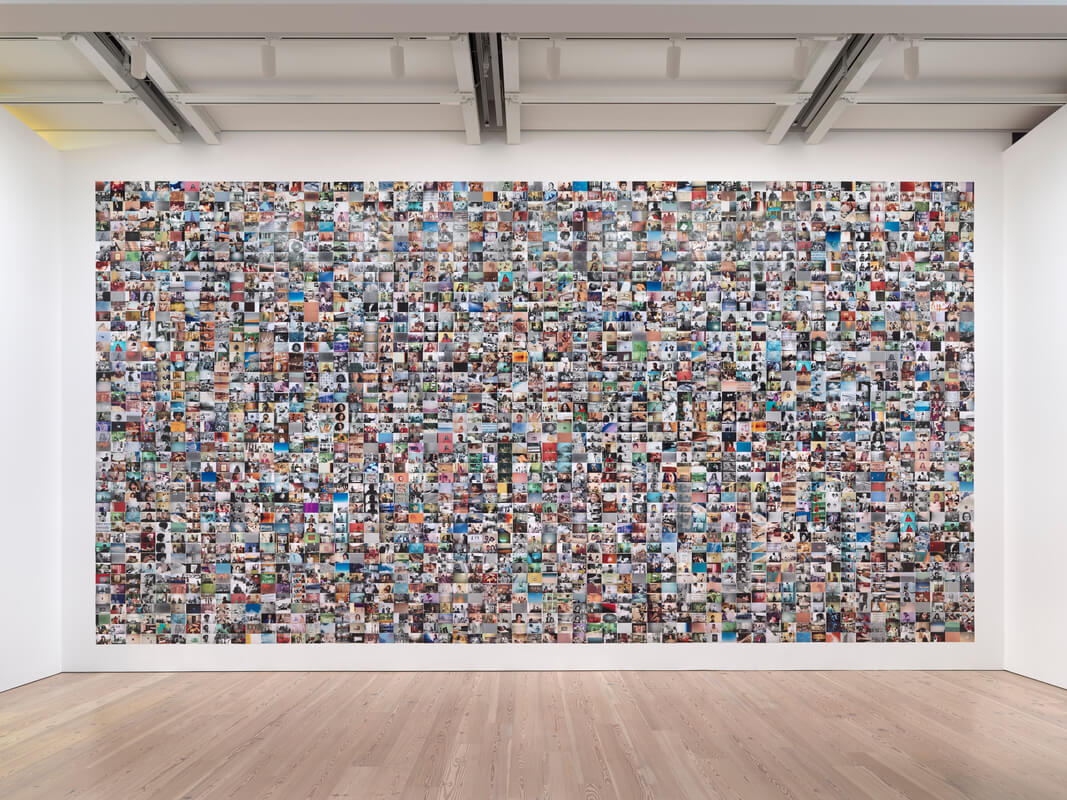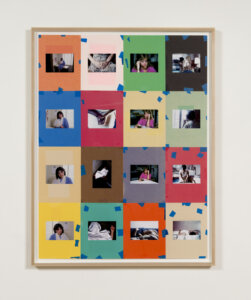The Jewish artist bringing abortion history to America’s museums
Currently on display at the Whitney Biennial, Carmen Winant’s installation of 2,500 archival photos chronicles the work of abortion providers and activists from 1973 to 2022

Carmen Winant’s photo installation, “The Last Safe Abortion,” chronicles 50 years of abortion care in the United States Photo by Ron Amstutz, Whitney Museum
If the past is indeed a foreign country, its foreignness is often most apparent through superficial similarities to the present.
That’s certainly true of Carmen Winant’s 2,500-photograph installation, “The Last Safe Abortion,” currently on display at the Whitney Biennial in New York. Occupying an enormous wall of the museum’s survey of contemporary art, this melange of archival snapshots depicts abortion care over the roughly 50 years during which Roe v. Wade upheld the constitutional right to terminate a pregnancy. Winant chose to tell this story through quotidian moments, focusing on clinic physicians and staff but also including stills from what look like classes, conferences, and protests. (None of the photographs are captioned, so interpretation is left to the beholder.) With a focus on familiar settings and tasks, the tapestry of photographs initially seems nostalgic, even comforting. But in the post-Dobbs era, with access to abortion far from guaranteed, Winant’s work reads like an elegy for a country that no longer exists.
A Jewish artist and photographer who teaches at the University of Ohio, Winant worked with clinics in the Midwest and South to collect images of the daily work of abortion care, dating from the procedure’s legalization in 1973 to the present day. Many are charmingly analog, like a photograph of clinic workers tabling at a resource fair, poster boards in tow. An older couple poses with a cardboard sign saying “WE HAVE SIX CHILDREN. WE ARE PRO CHOICE.” An empty exam room waits for a patient’s arrival. A clinic staffer, pictured over eight stills, turns from her phone to throw a half-smile at the camera. Two people raise their fists in solidarity, next to a snowman (or woman?) sculpted into the same gesture. Speakers lean towards classroom podiums, and deft latex gloved-hands sanitize medical equipment.

Viewers need not have experience with abortion care to appreciate these photographs; if you’ve ever stepped into one of the ubiquitously ugly brick-and-glass medical complexes pictured in the installation, you’ll feel a spark of recognition. Winant’s grainy interiors brought my pediatrician to mind; a no-nonsense receptionist reminded me I’m months overdue for a visit to the dentist. This isn’t to say that the tableau implies anything like ease or consensus around the right to abortion: A banner emblazoned with the slogan “Women have died because of Hyde” (referring to the 1977 Hyde Amendment, which bans the use of any federal funds for abortion) testify to the constant setbacks that followed Roe. But the radical nature of Winant’s project lies in its air of prosaic pragmatism, its determination to perceive and present abortion as a form of healthcare like any other.
That quality is also what makes these photographs, some only a few years old, feel completely divorced from our current reality. It’s difficult to conceive of abortion as everyday healthcare when 21 states have banned or severely restricted access to the procedure since the Supreme Court struck down Roe in 2022. When every month yields a newly medieval news story of women with nonviable pregnancies waiting until the literal brink of death for medical intervention, and child rape victims fleeing their home states for care or giving birth as pre-teens, the decades of work embodied in “The Last Safe Abortion” seem cruelly futile.

Labyrinthine guides on avoiding surveillance while getting an abortion (you’ll want a burner phone) remind us that past movements can provide only limited guidance to the new challenges of our current moment. And when women who help friends obtain abortions become vulnerable to drastic lawsuits, it’s easy to conclude that the work of stewarding these rights lies with well-lawyered organizations like Planned Parenthood, not individuals.
“The Last Safe Abortion” doesn’t offer much consolation for the dismal state of reproductive healthcare today. If anything, an accompanying Winant photo collage on the opposite wall, which depicts domestic violence victims with bruised faces and battered limbs, gestures at the brutality that comes with the loss of bodily autonomy. But the thousands of photographs, which Winant arranged to contain a “warp and weft” — a visual logic without a definitive schematic — constitute a powerful reminder that abortion care has always been a patchwork of loosely organized individual efforts, small-scale movements which can only grow more important as institutions and politicians fail pregnant people.
We don’t know what that will look like in the era of Dobbs v. Jackson. But if you’re wondering what you might do, or where your photo might lie in the photo tapestry another artist will create 50 years from now, you can go to the Whitney and get some ideas.























